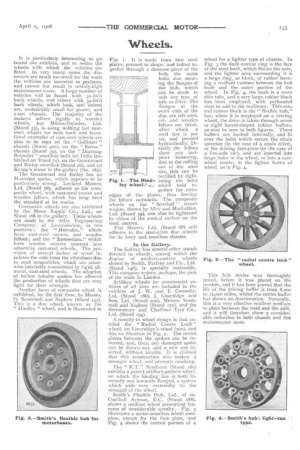Wheels.
Page 43

If you've noticed an error in this article please click here to report it so we can fix it.
it is particularly interesting to go round the exhibits, and to notice the wheels with which the vehicles are fitted. In very many cases the diameters are much too small for the work the vehicles are intended to perform, and cannot but result in unduly-high maintenance costs. A large number of vehicles will be found with 32-inch back wheels, and others with 34-inch back wheels, which look, and indeed are, undesirably small for 30-cwt. and 2-ton chassis. The majority of the makers adhere rigidly to wooden wheels, but MiInes-Daimler, Ltd. (Stand 53), is using nothing but caststeel wheels for both back and front. Good examples of cast-steel wheels are also to be seen od the " Gallinari " chassis (Stand 4oa), on the " Berna " chassis (Stand 39), on the " DarracqSerpollet " omnibus built for India (exhibited on Stand 74), on the Greenwood and Batley omnibus (Stand 26), and on Krupp'a stand in the gallery (No. 185).
The Greenwood and Batley has an II-section spoke, which appears to be particularly strong. Leyland Motors, Ltd. (Stand 76), adheres to the composite wheel, with cast-steel centre and wooden felines, which has long been the standard at its works.
Composite wheels are also exhibited by the Motor Supply Co., Ltd., on Stand 168 in the gallery. These wheels are made by the Atlas Engineering Company, of Levenshulme, in two patterns : the " Hercules," which have cast-steel centres and wooden felloes; and the " Sarnsonian," which have wooden eentres inserted into otherwise cast-steel wheels. The provision of several inches of wood insulates the axle from the vibrations due to road inequalities, which are otherwise inevitably transmitted by rigid, allmetal, cast-steel wheels. The adoption of hollow tubular spokes has allowed the production of wheels that are very light for their strength.
Another form of composite wheel is exhibited, for the first time, by Messrs. G. Scammell and Nephew (Stand 152). This is a disc wheel, known as the " Hindley " wheel, and is illustrated in
Fig i. It is made from two steel plates, pressed to shape, and bolted together through a distance piece at the hub, the same bolts also securing the flanges of the hub, which can be made to suit any type of axle or drive. The flanges at the outer ends of the disc are left conical, and wooden felloes are fitted, after which a steel tire is put on, and pressed hydraulically. pirectly the felloes show any incipient loosening, due to the rolling out of the steel tire, this can be rectified by tightening the belts which hold together the outer edges of the plates, thus forcing the felloes outwards. The composite wheels on the " Sentinel " steam wagon, shown by Alley and MacLellan, Ltd. (Stand 5), can also be tightened by virtue of the conical surface on the steel centres.
Fiat Motors, Ltd. (Stand 68) still adheres to the steel-plate disc wheels for its lorry and omnibus chassis.
Fig. 1. —The Hindley wheel.'
In the Gallery.
The Gallery has several other stands devoted to wheels; among which the display ef artillery-pattern wheels shown by Smith, Parfrey and Co., Ltd. (Stand 146), is specially noticeable. This company enjoys, perhaps, the pick of the trade in London.
Artillery wheels for commercial vehicles of all sizes are included in the exhibits of J. W. and T. Connolly, Ltd. (Stand 186), J. Liversidge and Son, Ltd. (Stand 200), Messrs. Scammell and Nephew (Stand 152), and the Shrewsbury and Challiner Tyre Co., Ltd. (Stand 194).
A novelty in wheel design is that entitled the " Radial Centre Lock " wheel, on Liversidge's stand (200), and this we illustrate in Fig. 2. The centre pieces between the spokes can be removed, and, thus, any damaged spoke can be drawn out, and a new one inserted, without trouble. It is claimed that this construction also makes a stronger wheel, and prevents creaking.
The " K.T." Syndicate (Stand 180 exhibits a patent artillery-pattern wheel, on which the binding tire is both internally and inwardly flanged, a system which adds very materially to the strength of the wheel.
Smith's Flexible Hub, Ltd., of 20, Copthall Avenue, E.C. (Stand 388), shows a resilient wheel presenting features of considerable novelty. Fig. 3 illustrates a motor-omnibus wheel complete, except for the face plate, and Fig. 4 shows the central portion of a wheel for a lighter type of chassis. In Fig. 3 the dark central ring is the face of the steel bush, which fits on the axle, and the lighter area surrounding it is a large ring, or block, of rubber forming a resilient cushion between the hub bush and the outer portion of the wheel. In Fig. 4, the bush is a mere thin tube, and a very large rubber block has been employed, with perforated slots to add to the resilience. This central rubber block is the " flexible hub," but, when it is employed on a driving wheel, the drive is taken through seven or eight barrel-shaped rubber buffers, as may be seen in both figures. These buffers are bushed internally, and fit over the bolts which secure the chain sprocket (in the case of a chain drive), or the driving face-plate (in the case of a live-axle car), and are inserted into large holes in the wheel, or into a castwheel centre, in the lighter forms of wheel, as in Fig. 4.
This hub device was thoroughly tested, before it was placed on the market, and it has been proved that the life of the driving buffer is from 8,000 to 12,000 miles, whilst the centre buffer has shown no deterioration. Naturally, this is a very effective resilient medium to place between the road and the axle, and it will therefore shown considerable reduction in both chassis and tire maintenance costs.




























































